
Saturn IX
Phoebe [FEE-bee], one of the outer satellites of Saturn, was discovered by William H. Pickering from a photographic plate taken on the night of August 16, 1898 with a 24-inch refracting telescope located in Areguipa, Peru. At a distance of 12,952,000 kilometers (8 million miles), Phoebe orbits Saturn in a retrograde direction (opposite to the direction of the other satellites' orbits) in a plane much closer to the ecliptic than to Saturn's equatorial plane. It is 214 kilometers (133 miles) in diameter, roughly circular in shape, and fairly dark reflecting about 8 percent o f the sunlight. Phoebe rotates on its axis every nine hours and 16 minutes, and completes a full orbit around Saturn in about 18 months. Phoebe also might be the source of dark material on Iapetus.

|
| Phoebe as viewed by Voyager 2. (© Calvin J. Hamilton) [more] |
On June 11, 2004 the real nature of Phoebe was uncovered during the flyby of the Cassini spacecraft at a distance of 2,068 kilometers (1,285 miles). This was more than 1000 times closer than Voyager 2. The Cassini findings suggest that Phoebe may be a frozen artifact of a bygone era, some four billion years ago. It is likely a primordial mixture of ice, rock and carbon-containing compounds similar in many ways to material seen in Pluto and Neptune's moon Triton. Scientists believe bodies like Phoebe were plentiful in the outer reaches of the solar system about four and a half billion years ago
These icy planetesimals (small bodies) formed the building blocks of the outer solar system and some were incorporated into the giant planets Jupiter, Saturn, Uranus and Neptune. During this process, gravitational interactions ejected much of this material to distant orbits, joining a native population of similar bodies to form the Kuiper Belt.
Phoebe apparently stayed behind, trapped in orbit about the young Saturn. Cassini has unveiled that Phoebe's surface is heavily potholed with large and small craters. Images reveal bright streaks in the ramparts of the largest craters, bright rays which emanate from smaller craters, and uninterrupted grooves across the face of the body. Its surface is made of water ice, water-bearing minerals, carbon dioxide, possible clays and primitive organic chemicals in patches at different locations on the surface.
One intriguing result is the discovery of possible chemical similarities between the materials on Phoebe and those seen on comets. Evidence that Phoebe might be chemically kin to comets strengthens the case that it is similar to Kuiper Belt Objects.
Phoebe's mass was determined from precise tracking of the spacecraft and optical navigation, combined with an accurate volume estimate from images. The measurements yield a density of about 1.6 grams per cubic centimeter (100 pounds per cubic foot), much lighter than most rocks, but heavier than pure ice at approximately 0.93 grams per cubic centimeter (58 pounds per cubic foot). This suggests a composition of ice and rock similar to Pluto and Triton.
Measurements taken by the composite infrared spectrometer were used to generate temperature maps. The maps show the surface of Phoebe is very cold, only about 110 degrees above absolute zero (minus 163 degrees Celsius, or minus 261 degrees Fahrenheit). Even colder nighttime temperatures suggest a fluffy, porous surface layer.
As the Cassini findings are further studied, even more conclusions may be formed about Saturn's amazing moon Phoebe and the formation of our solar system.
| Phoebe Statistics | |
|---|---|
| Discovered by | William Henry Pickering |
| Date of discovery | 1898 |
| Mass (kg) | 4.0e+18 |
| Mass (Earth = 1) | 6.6934e-07 |
| Equatorial radius (km) | 110 |
| Equatorial radius (Earth = 1) | 1.7247e-02 |
| Mean density (gm/cm^3) | 0.7 |
| Mean distance from Saturn (km) | 12,952,000 |
| Rotational period (days) | 0.4 |
| Orbital period (days) | -550.48 |
| Mean orbital velocity (km/sec) | -1.71 |
| Orbital eccentricity | 0.1633 |
| Orbital inclination (degrees) | 175.3 |
| Escape velocity (km/sec) | 0.0697 |
| Visual geometric albedo | 0.06 |
| Magnitude (Vo) | 16.45 |
 The Face of Phoebe
The Face of Phoebe
Phoebe's true nature is revealed in startling clarity in this
mosaic of two images taken during Cassini's flyby on June 11, 2004.
The image shows evidence for the emerging view that Phoebe may be
an ice-rich body coated with a thin layer of dark material. Small
bright craters in the image are probably fairly young features. This
phenomenon has been observed on other icy satellites, such as
Ganymede at Jupiter. When impactors slammed into the surface of
Phoebe, the collisions excavated fresh, bright material -- probably
ice -- underlying the surface layer. Further evidence for this can
be seen on some crater walls where the darker material appears to
have slid downwards, exposing more light-colored material. Some areas
of the image that are particularly bright - especially near lower
right - are over-exposed.
(Courtesy NASA/JPL/Space Science Institute)
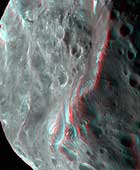 Phoebe in 3-D
Phoebe in 3-D
Phoebe's violent, cratered past is more evident in this 3-D image of the
tiny moon.
The Sun is coming from the left, illuminating craters and bumps on the surface, along with a prominent ridge-like feature in the middle. Bright material, likely to be ice, is exposed atop this ridge-like feature as well as around small craters and down the slopes of large craters. There are also bright streaks on steep slopes, perhaps where loose material slid downhill during the seismic shaking of impact events.
This 3-D mosaic is made up of two images taken with the Cassini spacecraft
narrow angle camera on June 11, 2004. The right image was taken from a
range of 15,215 kilometers (9,454 miles) to the surface of Phoebe, through
a clear filter. The left image was taken from a range of 20,085 kilometers
(12,480 miles) to the surface of Phoebe, through clear and infrared
filters. The image scale ranges from 92 meters (301.8 feet) per pixel
(right image) to 482 meters (1,581 feet) per pixel (left image). The left
image has been altered to match the right image here.
(Courtesy NASA/JPL)
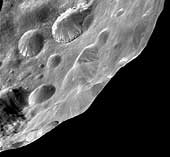 Phoebe's Surprise
Phoebe's Surprise
Phoebe delivers on its promise to reveal new wonders to Cassini
by showing probable evidence of an ice-rich body overlain with a
thin layer of dark material. The sharply-defined crater at above
center exhibits two or more layers of alternating bright and dark
material. Imaging scientists on the Cassini mission have
hypothesized that the layering might occur during the crater
formation, when ejecta thrown out from the crater buries the
pre-existing surface that was itself covered by a relatively thin,
dark deposit over an icy mantle. The lower thin dark layer on the
crater wall appears to define the base of the ejecta blanket. The
ejecta blanket itself appears to be mantled by a more recent dark
surface lag.
This image was obtained on June, 11 2004 at a phase, or
Sun-Phoebe-spacecraft, angle of 79 degrees, and from a distance of
13,377 kilometers (8,314 miles). The image scale is approximately
80 meters (263 feet) per pixel. No enhancement was performed on this image.
(Courtesy NASA/JPL/Space Science Institute)
 A Skyline View
A Skyline View
Images like this one, showing bright wispy streaks thought to be ice
revealed by subsidence of crater walls, are leading to the view that
Phoebe is an ice-rich body overlain with a thin layer of dark material.
Obvious down slope motion of material occurring along the walls of the
major craters in this image is the cause for the bright streaks, which
are over-exposed here. Significant slumping has occurred along the crater
wall at top left.
The slumping of material might have occurred by a small projectile punching into the steep slope of the wall of a pre-existing larger crater. Another possibility is that the material collapsed when triggered by another impact elsewhere on Phoebe. Note that the bright, exposed areas of ice are not very uniform along the wall. Small craters are exposing bright material on the hummocky floor of the larger crater.
Elsewhere on this image, there are local areas of outcropping along the larger crater wall where denser, more resistant material is located. Whether these outcrops are large blocks being exhumed by landslides or actual 'bedrock' is not currently understood.
The crater on the left, with most of the bright streamers, is about 45 kilometers (28 miles) in diameter, front to back as viewed. The larger depression in which the crater sits is on the order of 100 kilometers (62 miles) across. The slopes from the rim down to the hummocky floor are approximately 20 kilometers (12 miles) long; many of the bright streamers on the crater wall are on the order of 10 kilometers (6 miles) long. A future project for Cassini image scientists will be to work out the chronology of slumping events in this scene.
This image was obtained at a phase, or Sun-Phoebe-spacecraft, angle of 78
degrees, and from a distance of 11,918 kilometers (7,407 miles). The
image scale is approximately 70 meters (230 feet) per pixel. No
enhancement was performed on this image.
(Courtesy NASA/JPL/Space Science Institute)
 Crater close-up on Phoebe
Crater close-up on Phoebe
This eye-popping high-resolution image of Phoebe's pitted surface taken
very near closest approach shows a 13-kilometer (8-mile) diameter crater
with a debris-covered floor. Part of another crater of similar size is
visible at left, as is part of a larger crater at top and many scattered
smaller craters. The radial streaks in the crater are due to down slope
movements of loose fragments from impact ejecta. Also seen are boulders
ranging from about 50 to 300 meters (160 to 990 feet) in diameter. The
building-sized rocks may have been excavated by large impacts, perhaps
from some other region of Phoebe rather than the craters seen here.
There is no visible evidence for layering of ice and dark material or
a hardened crust in this region, as on other parts of this moon.
Some of the relatively bright spots are from small impacts that
excavated bright material from beneath the dark surface. Images like
this provide information about impact processes on Phoebe.
(Courtesy NASA/JPL/Space Science Institute)
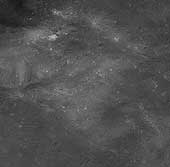 Dark Desolation
Dark Desolation
On June 11, 2004, during its closest approach to Phoebe, Cassini obtained
this extremely high resolution view of a dark, desolate landscape. Regions
of different reflectivity are clearly visible on what appears to be a
gently rolling surface. Notable are several bright-rayed impact craters,
lots of small craters with bright-colored floors and light-colored streaks
across the landscape. Note also the several sharply defined craters --
probably fairly young features -- near the upper left corner.
This high-resolution image was obtained at a phase, or
Sun-Phoebe-spacecraft, angle of 30.7 degrees, and from a distance of
approximately 2,365 kilometers (1,470 miles). The image scale is
approximately 14 meters (46 feet) per pixel. The image was high-pass
filtered to bring out small scale features and then enhanced in contrast.
 A View to the South
A View to the South
A mosaic of two images of Saturn's moon Phoebe taken shortly after
Cassini's flyby on June 11, 2004, gives a close-up view of a region near
its South Pole. The view, taken about 13,000 kilometers (8,000 miles)
from Phoebe, is about 120 kilometers (74 miles) across and shows a region
battered by craters. Brighter material, likely to be ice, is exposed by
small craters and streams down the slopes of large craters. The skyline
is a combination of Phoebe's shape and the formation of impact
craters. Walls of some of the larger craters are more than 4 kilometers
(2.5 miles) high. The image scale is 80 meters (264 feet) per pixel.
 Peering at Phoebe
Peering at Phoebe
Shown here is a mosaic of seven of the sharpest, highest resolution
images taken of Phoebe during Cassini's close flyby of the tiny moon.
The image scales range from 27 to 13 meters (90 to 43 feet) per pixel.
Smaller and smaller craters can be resolved as resolution increases from
left to right. The number of blocks, or bumps on the surface also
increases to the right. The Sun is coming from the right, so the
bright-dark pattern is reversed between blocks and small craters. Grooves
or chains of pits are seen on the left portion of the mosaic, which may
mark fractures or faults induced by large impact events. Many of the
small craters have bright rays, similar to recent craters on the Moon.
There are also bright streaks on steep slopes, perhaps where loose
material slid downhill during the seismic shaking of impact events.
There are also places where especially dark materials are present,
perhaps rich in carbon compounds.
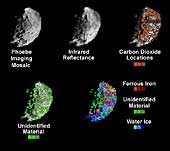 Phoebe's Mineral Distribution
Phoebe's Mineral Distribution
These set of images were created during the Phoebe flyby on June 11, 2004.
The images show the location and distribution of water-ice, ferric iron,
carbon dioxide and an unidentified material on the tiny moon of Saturn.
The first image was taken with Cassini's narrow angle camera and is shown
for comparison purposes only. The other images were taken by the visual
and infrared mapping spectrometer onboard Cassini.
The infrared image of Phoebe obtained at a distance of about 16,000 km (10,000 miles) shows a large range of bright and dark features. The resolution of the image is about 4 km (2.5 miles). carbon dioxide on the surface of Phoebe is distributed globally, although it appears to be more prevalent in the darker regions of the satellite.
The existence of carbon dioxide strongly suggests that Phoebe did not originate in the asteroid belt, but rather in much colder regions of the Solar System such as the Kuiper Belt. The Kuiper Belt is a vast reservoir of small, primitive bodies beyond the orbit of Neptune. An unidentified substance also appears to be more abundant in the darker regions.
A map showing the distribution of water ice (blue), ferric iron (red),
which is common in minerals on Earth and other planets, and the
unidentified material (green). Water ice is associated with the brighter
regions, while the other two materials are more abundant in the darker
regions.
 Phoebe's Radiation
Phoebe's Radiation
This image shows thermal radiation from the day and night sides of
Saturn's moon Phoebe, taken by the composite infrared spectrometer
onboard Cassini 1.8 hours before the spacecraft's closest approach to
Phoebe on June 11, 2004. The left-hand panel displays the image in
grayscale format, showing the brightness of Phoebe's radiation in the
wavelength range 15-17 microns, which is about 25 times the longest
wavelength visible to the naked eye. In the middle panel this brightness
is used to estimate the surface temperature distribution across Phoebe.
Temperatures are given in degrees Kelvin, and vary from a relatively
toasty 107 Kelvin (-267 Fahrenheit), in the late morning near the equator
(white, lower right), to less than 75 Kelvin (-324 Fahrenheit) in the
northern hemisphere in the pre-dawn hours (dark blue, upper left). The
"ragged edge" of Phoebe in this region is an instrumental artifact.
Temperatures are affected strongly by topography, as can be seen by
comparison with the visible-wavelength image (right). Some of the coldest
temperatures are found in the shadowed region inside the large depression
in the northern hemisphere (upper right).
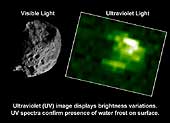 Phoebe in Ultraviolet
Phoebe in Ultraviolet
On the right, the ultraviolet image of Saturn's moon Phoebe, taken from a
distance of 31,000 kilometers (about 19,263 miles) shows an irregular
surface and bright crater region (white area). The bright areas indicate
water frost on Phoebe's surface. The image was taken by Cassini's
ultraviolet imaging spectrograph during the spacecraft's closest approach
to Phoebe, on June 11, 2004. The large crater shows clearly in the image
on the left.
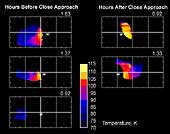 Phoebe Temperature Maps
Phoebe Temperature Maps
A montage of maps of Saturn's moon Phoebe shows surface temperatures at
various times of day as determined by the composite infrared spectrometer
onboard Cassini during the June 11, 2004, Phoebe flyby. The asterisk on
each map shows the location of the subsolar point, where the Sun is
directly overhead. This point moves across the surface as Phoebe rotates.
It is morning in regions to the left of the subsolar point, and afternoon
in regions to the right. Like a newspaper weather map, different colors
indicate different temperatures, though Phoebe's temperatures are
distinctly cooler than even the coldest January day on Earth. Equatorial
temperatures peak in the early afternoon near 112 Kelvin (-257
Fahrenheit), plunging to 78 Kelvin (-319 Fahrenheit) before dawn, and
are even colder at higher latitudes. The large day/night temperature
contrasts imply that Phoebe's surface is covered in loose dust or ice
particles that store little heat and thus cool off rapidly at night.
Regions of Phoebe's surface that were not observed are shown in black.
Most of the maps show the effect on surface temperatures of the large
crater-like depression seen in Cassini's visible-wavelength images of
Phoebe, which is located just left of center in these maps. Crater walls
that are shadowed and cold in the early morning in the first map are
sunlit and warm in the late afternoon in the final map.
 The True Shape of Phoebe
The True Shape of Phoebe
This colorful graphic illustrates that despite Phoebe's bumpy, irregular
topography, the moon has a fairly round shape. A digitally rendered shape
model of Phoebe was constructed using Cassini imaging data obtained before
and after the spacecraft's close flyby of the Saturnian moon on June 11,
2004.
The average diameter of Phoebe is about 214 kilometers (133 miles). The
four views of the model are each separated by a 90 degree rotation; the
upper left is centered at 0 degrees West longitude. The others show
regions of the moon centered at 90, 180 and 270 degrees West longitude,
as labeled. The coloring of the models corresponds to the height of
Phoebe's surface, relative to the lowest point -- a range of about 16
kilometers (10 miles) -- going from blue (low) to red (high).
Interestingly, much of this range in height occurs in one large crater,
visible in the 180 degree West view.
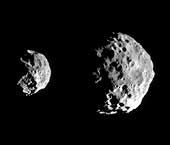 Battered Moon
Battered Moon
Early images returned from the first detailed reconnaissance of
Saturn's
small outer moon, Phoebe, show breathtaking details in the moon's
pockmarked surface that already have imaging scientists puzzling over
the body's history. The images are only a preview of what to expect from
the high resolution images to be examined later today which will show
details about 10 times smaller.
Phoebe has revealed itself to be a rugged, heavily cratered body, with overlapping craters of varying sizes. This morphology suggests an old surface. There are apparently many craters smaller than 1 km, indicating that projectiles probably smaller than 100 meters once pummeled Phoebe. Whether these objects were cometary or asteroidal in origin, or were the debris that resulted from impacts on other bodies within the Saturn system, is hotly debated. There is also variation in surface brightness across the body.
In the first image (at left) in which Phoebe looks somewhat like a sideways skull, the large crater near the bottom displays a complex and rugged interior. The lower right hand part of Phoebe appears to be covered by bright wispy material.
The second, higher resolution image further reveals the moon's battered surface, including a crater near the right hand edge with bright rays that extend outward from its center. This suggests that dark material coats the outside. Features reminiscent of those seen on the Martian moon Phobos -- such as linear grooves--are faintly visible in the upper part of this image. There are suggestions of linear ridges or grooves and of chains of craters, perhaps radial to a large crater just hidden on the un-illuminated region in the upper left.
Left to right, the two views were obtained at phase, or
Sun-Phoebe-spacecraft, angles of approximately 86 degrees, and from
distances ranging from 143,068 kilometers (88,918 miles) to 77,441
kilometers (48, 130 miles); for reference, Cassini's closest approach
to Phoebe was approximately 2,068 kilometers (1,285 miles). The image
scale ranges from 0.86 to 0.46 kilometers (0.53 to 0.29 miles) per pixel.
No enhancement of any kind has been performed on the images.
(Courtesy NASA/JPL/Space Science Institute)
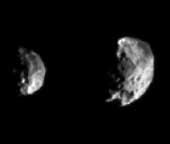 Countdown to Phoebe
Countdown to Phoebe
As Cassini sails toward its rendezvous with Phoebe, details on the small,
dark moon are coming into view at a dizzying pace. The images shown here were
taken 13 hours apart on June 10, 2004, just one day prior to closest approach.
There is a dramatic increase in detail between these two views. Phoebe completes
one rotation about its spin axis in nine hours and 16 minutes. We are looking at
opposite hemispheres in these two views.
A large crater, roughly 50 kilometers (31 miles) across, is visible in the image on the left. The image on the right shows a body heavily pitted with craters of varying sizes, including very large ones, and displaying a substantial amount of variation in surface brightness. Features that appear to be cliffs may be the boundaries between large craters. Despite its exaggerated topography, Phoebe is more round than irregular in shape.
Left to right, the two views were obtained at a phase, or Sun-Phoebe spacecraft angle, of 87 degrees, and from distances of 956,000 kilometers (594,000 miles) and 658,000 kilometers (409,000 miles), respectively. The image resolutions are 5.7 and 3.9 kilometers (3.5 to 2.4 miles) per pixel, respectively. To aid visibility, the images were magnified three times via linear interpolation; no contrast enhancement was performed.
Phoebe is approximately 220 kilometers (137 miles) wide. On Phoebe, the spin
axis points up and approximately 13 degrees to the left of the boundary between
day and night. Cassini draws closer to its only flyby of this mysterious outer
moon of Saturn. Closest approach to Phoebe will be at 1:56 p.m. Pacific Time
on June 11.
(Courtesy NASA/JPL/Space Science Institute)

 Saturn
Saturn Iapetus
Iapetus